By Luis Amezcua
 Late last year, in a move with the potential to impede the growth of rooftop solar in the City of Alameda, the public electric utility Alameda Municipal Power slashed compensation to its solar customers by roughly half.
Late last year, in a move with the potential to impede the growth of rooftop solar in the City of Alameda, the public electric utility Alameda Municipal Power slashed compensation to its solar customers by roughly half.
Alameda Municipal Power achieved this unfortunate outcome by adopting a “successor tariff” for its Net Energy Metering program. To understand what that means in plain English, you have to understand the relationship between rooftop-solar customers and utilities. Under current law, solar customers receive credit for excess power they give back to the grid after satisfying their own energy needs—a relationship known in the energy industry as “net metering”. Once customers’ combined solar give-backs reach five percent of the utility’s total generation capacity, a mechanism called a “successor tariff” administers how customers will be compensated for solar power by the utility.
Normally, solar customers would be compensated for their excess electricity at the same rate their utility charges for electricity. This is still the case for customers who are served by the three major utilities: Pacific Gas & Electric, Southern California Edison, and San Diego Gas & Electric. Now, however, solar-power-generating Alameda Municipal Power customers will receive less compensation for the power they provide the utility, and they will pay more for the power the utility provides to them.
Net metering programs are crucial in incentivizing solar, and they’re a driving force in the transition away from fossil fuels to a clean energy economy. If a net metering program does not pay solar residents a fair value for the clean electricity they produce and give back to the grid, there is a risk of disincentivizing solar and impeding the overall growth of solar in the region. The California Public Utilities Commission recognized such a risk when it adopted a successor tariff in 2015 that included full retail compensation for customers of the three major utilities (despite the utilities’ opposition).
Rooftop solar provides numerous benefits, including: decreasing the need for new generating capacity; providing upgrades to local distribution infrastructure; and reducing the distance between the generation and the demand. Rooftop solar also provides residents and business with an opportunity to take climate action and empowers them to save on their utility bills through clean energy. Over the last four years, the solar industry has grown significantly, employing more people than the state’s three major utilities combined.
The Sierra Club opposed Alameda Municipal Power’s successor tariff proposal when it came to the board last July, and we are disappointed to see essentially the same proposal adopted in later months. We will continue our efforts to educate Alameda Municipal Power about the benefits of rooftop solar and its contribution to the grid. We hope that Alameda Municipal Power will soon join the Bay Area, along with the brand-new East Bay Community Energy (Alameda County’s local power agency), in being an environmental leader for the rest of California and the country.
Photo: rooftop solar panels, courtesy Chris "64MM" via Flickr Creative Commons.